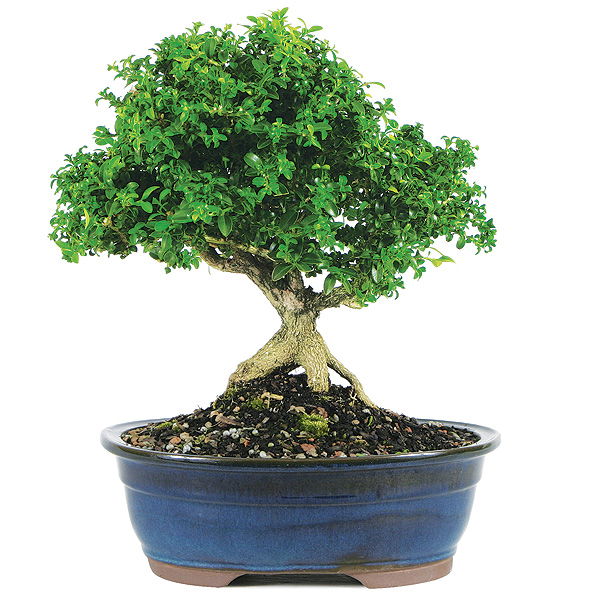
General Background:
Boxwoods are densely branched shrubs that are native to Europe and Asia. A hedge steeped in history, box sprigs are known to have been found in the tombs of Roman nobility. It is widely used as a hedge plant, and is a common topiary subject as well. The boxwood is an important plant commercially, as it is one of the few woods that are heavier than water, and because of this, it is used for making woodcuts and precision instruments. Most boxwood plants are grown as hardy bonsai, and are very popular for use in this calming art due to its tiny leaves and flowers as well as its tolerance for extensive pruning and shaping. It is a hearty slow growing plant that is perfect for any bonsai lover, tolerating neglect and inexperience without detriment to its attractive habit.
Trees Features:
This boxwood is unique among boxwoods for its scentless evergreen leaves that are less than 1 inch long. Kingsville Dwarf Boxwood is the most sought after member of the “Buxus” family. It features dark green, tiny leathery leaves, dense growth habits and rough bark which are all the features that make it a good bonsai subject. Branches grow horizontally making it look like a miniature version of a 100 year old shade tree.
Temperature:
All boxwoods need protection from frost and cold winds even when grown in the proper climate. Thus, it is important to either place in a cold frame with ample root protection, or bring indoors once weather begins to show signs of frost. In the summer, your boxwood will enjoy being brought back outside as it appreciates fresh air.
Lighting:
The easy to maintain Boxwood Bonsai is not picky about lighting conditions and easily tolerates both sun and shade and has an indoor light requirement of only 800 Lux which makes it a great plant for indoor locations that have lower levels of light.
Watering:
The boxwood bonsai enjoys moderate moisture levels, but does not like wet soil. It is fairly drought tolerant and will need to dry somewhat between watering.
Fertilizing:
You will want to feed this bonsai every two weeks during growth. Use a liquid bonsai fertilizer with one application of pulverized organic fertilizer during active growth.
Pruning / Training:
Growth on the dwarf varieties of boxwood is very slow making it a great subject for those who don’t have much time for pruning and shaping. This bonsai can be wired at any time and is very is tolerant of radical treatments, such as jinn, shari and being grown in root over rock styles. Control shape by thinning and by pinching off most of unwanted new growth.
Insects / Pests:
Although your boxwood bonsai is very disease and pest resistant, honey fungus and rust are sometimes encountered. Proper health can be usually maintained with proper soil and water conditions. It is also prudent to ensure that this bonsai is free from dust. A little tender loving care will go a long way with this hearty plant allowing you to enjoy years of pest free enjoyment.
Propagation:
You can propagate your boxwood bonsai with hardwood cuttings taken in late summer or autumn. Dip cuttings in rooting hormone and place in moist soil in a shady location to promote proper root development.
Repotting:
You can repot your boxwood every two years in the spring, though there is a lot more leeway allowed than with a deciduous tree. It can also be repotted in the summer or fall if needed, though you would want to avoid repotting during the hottest months. Use basic low acid bonsai soil and add an occasional dose of lime to the soil for optimal health. Ensure that the soil drains well to prevent root rot.
Additional Comments:
One note of caution: box leaves are poisonous, and eating even a few can kill a small pet. As such, be sure to always keep this bonsai out of a child’s or animal’s reach.
DISCLAIMER: The content provided in this article is not warranted or guaranteed by Bonsai Outlet. The content provided is intended for entertainment and/or educational purposes in order to introduce to the reader key ideas, concepts, and/or product reviews. We are not liable for any negative consequences that may result from implementing any information covered in our articles or tutorials. Happy bonsai gardening.



